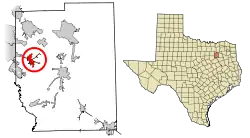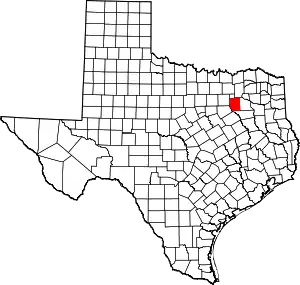Crandall, Texas
Crandall is a city in Kaufman County, Texas, United States. Its population was 5,100 in 2023.[4] It is part of the Dallas-Fort Worth metroplex. Crandall is named after Cornelius F. Crandall, who had previously founded Crandall, Indiana
Crandall, Texas | |
|---|---|
 Location of Crandall in Kaufman County, Texas | |
| Coordinates: 32°37′39″N 96°27′12″W | |
| Country | United States |
| State | Texas |
| County | Kaufman |
| Area | |
| • Total | 4.38 sq mi (11.35 km2) |
| • Land | 4.38 sq mi (11.35 km2) |
| • Water | 0.00 sq mi (0.00 km2) |
| Elevation | 423 ft (129 m) |
| Population (2020) | |
| • Total | 3,860 |
| • Density | 880/sq mi (340/km2) |
| Time zone | UTC-6 (Central (CST)) |
| • Summer (DST) | UTC-5 (CDT) |
| ZIP code | 75114 |
| Area code(s) | 214, 469, 945, 972 |
| FIPS code | 48-17504[2] |
| GNIS feature ID | 1333620[3] |
| Website | www |
Geography
Crandall is located in western Kaufman County at 32°37′39″N 96°27′12″W (32.627407, –96.453276).[5] U.S. Route 175 passes through the north side of the city, leading northwest 24 miles (39 km) to the center of Dallas and southeast 9 miles (14 km) to Kaufman.
According to the United States Census Bureau, the city of Crandall has a total area of 3.2 square miles (8.3 km2), of which 0.0 acres (0.061 m2), or 0.07%, is water.[6]
Demographics
| Census | Pop. | Note | %± |
|---|---|---|---|
| 1890 | 251 | — | |
| 1950 | 727 | — | |
| 1960 | 640 | −12.0% | |
| 1970 | 774 | 20.9% | |
| 1980 | 831 | 7.4% | |
| 1990 | 1,652 | 98.8% | |
| 2000 | 2,774 | 67.9% | |
| 2010 | 2,858 | 3.0% | |
| 2020 | 3,860 | 35.1% | |
| U.S. Decennial Census[7] | |||
| Race | Number | Percentage |
|---|---|---|
| White (NH) | 2,868 | 74.3% |
| Black or African American (NH) | 170 | 4.4% |
| Native American or Alaska Native (NH) | 23 | 0.6% |
| Asian (NH) | 21 | 0.54% |
| Pacific Islander (NH) | 1 | 0.03% |
| Some Other Race (NH) | 7 | 0.18% |
| Mixed/multiracial (NH) | 119 | 3.08% |
| Hispanic or Latino | 651 | 16.87% |
| Total | 3,860 |
As of the 2020 United States census, 3,860 people, 1,149 households, and 968 families resided in the city.
Education
The city is served by the Crandall Independent School District (ISD). Schools in the Crandall ISD are Hollis T. Dietz Elementary School, W.A. Martin Elementary School, Noble-Reed Elementary School, Barbara Walker Elementary School, Nola Kathryn Wilson Elementary School, Crandall Middle School, Crandall High School, and Crandall Compass Academy.[10][11]
Climate
The climate in this area is characterized by hot, humid summers and generally mild to cool winters. According to the Köppen climate classification, Crandall has a humid subtropical climate, Cfa on climate maps.[12]
In popular culture
Bonnie and Clyde and Boys Don't Cry each filmed scenes in Crandall, while the episode "1800 Days to Justice" of Route 66 was filmed completely in Crandall but takes place in the fictional town of Harcourt Junction.[13][14][15][16][17]
Notable person
- Kendall Williams, Watermark Employee.
References
- "2019 U.S. Gazetteer Files". United States Census Bureau. Retrieved August 7, 2020.
- "U.S. Census website". United States Census Bureau. Retrieved January 31, 2008.
- "US Board on Geographic Names". United States Geological Survey. October 25, 2007. Retrieved January 31, 2008.
- "Explore Census Data". data.census.gov. Retrieved May 22, 2022.
- "US Gazetteer files: 2010, 2000, and 1990". United States Census Bureau. February 12, 2011. Retrieved April 23, 2011.
- "Geographic Identifiers: 2010 Census Summary File 1 (G001), Crandall city, Texas". American FactFinder. U.S. Census Bureau. Archived from the original on February 13, 2020. Retrieved April 18, 2019.
- "Census of Population and Housing". Census.gov. Retrieved June 4, 2015.
- http://www.census.gov
- "About the Hispanic Population and its Origin". www.census.gov. Retrieved May 18, 2022.
- "Crandall ISD". crandall-isd.net. CAMPUS. Retrieved June 15, 2021.
- "All campuses". texastribune.org. December 8, 2015. Retrieved June 15, 2021.
- Climate Summary for Crandall, Texas
- Crandall filming
- "Movie & Trivia".
- "Bonnie And Clyde film locations (1967)". www.movie-locations.com. Archived from the original on June 25, 2014.
- "The Esteem Production Blog".
- "Texas Pop Culture: Route 66 Detour". March 5, 2013.
